Post-war use of pistols manufactured and developed in Nazi Germany
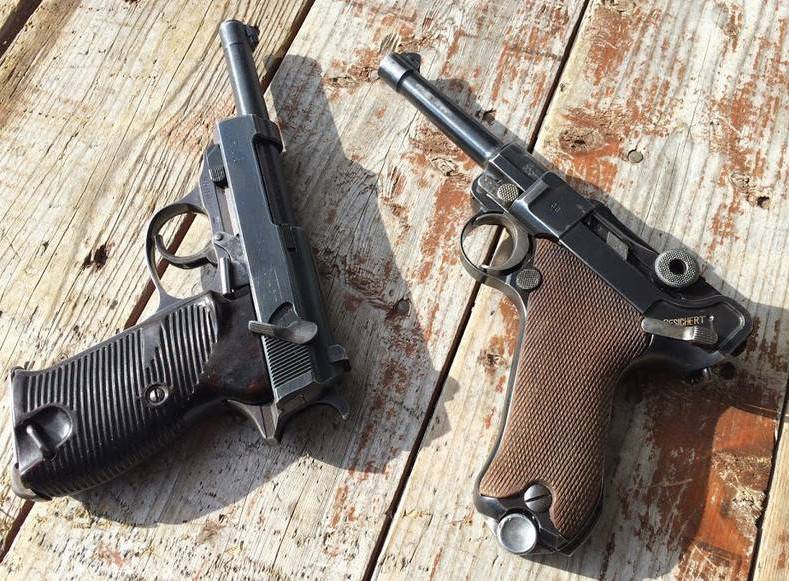
After the end of World War II, the victorious countries got millions of small arms weaponsmade in the Third Reich. A significant part of the trophies left after the surrender of Nazi Germany, due to redundancy and poor condition, went to open-hearth furnaces, but a considerable number of samples of small arms were used for their intended purpose, delivered to third countries or, after conservation, were sent for long-term storage, where they sometimes stayed for more than 50 years .
During the Second World War, the Wehrmacht, the SS troops and various German armed formations had a large number of pistols of different models captured in European countries, but today we will consider short-barreled weapons of German origin, produced in Germany, or the same samples produced at enterprises located under the control of the occupation administration.
Pistols chambered for 9 × 19 mm Parabellum: Luger P.08 and Walther R.38
The standard German army pistol after World War I was the Luger P.08. For firing from it, a cartridge of 9 × 19 mm Parabellum, which was quite powerful for that time, was used, which, at distances typical for firing from short-barreled weapons, provided a good stopping and lethal effect.
The exact number of Lugers produced is unknown. According to some reports, taking into account assembly outside Germany, up to 3 million copies could be produced. However, not all pistols made at German enterprises ended up in the German army, some were sold abroad. According to a number of sources, the German armed forces from 1908 to 1944 received more than 2,4 million pistols.
It is noteworthy that the Kaiser fleet in 1904 adopted the Luger into service earlier than the army. The "Marine Model" had a barrel length of 147 mm and sights designed for firing up to 200 m.
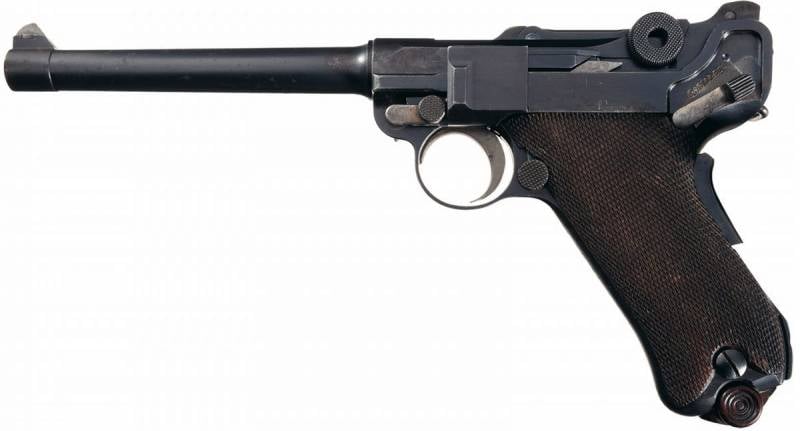
9mm pistol Luger M.1904
The Luger P.08 pistol (also known as the Parabellum) officially entered service with the Kaiser's army in 1908.
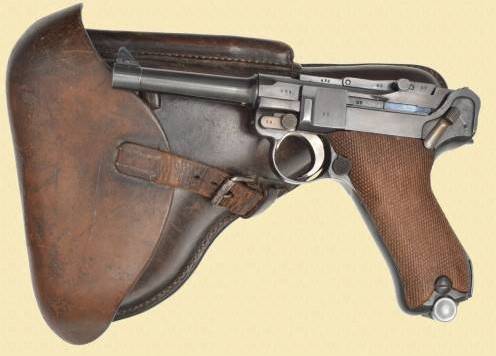
9mm Luger P.08 pistol with holster
The most notable innovations were the disappearance of the automatic safety at the back of the handle, the use of a coiled cylindrical return spring and an extractor combined with an indicator of the presence of a cartridge in the chamber. To put the weapon on the fuse, it was necessary to turn the fuse lever down. As in the “Sea Model”, the automatic pistol is based on the scheme of using recoil with a short barrel stroke. The barrel bore is locked using a system of hinged levers.
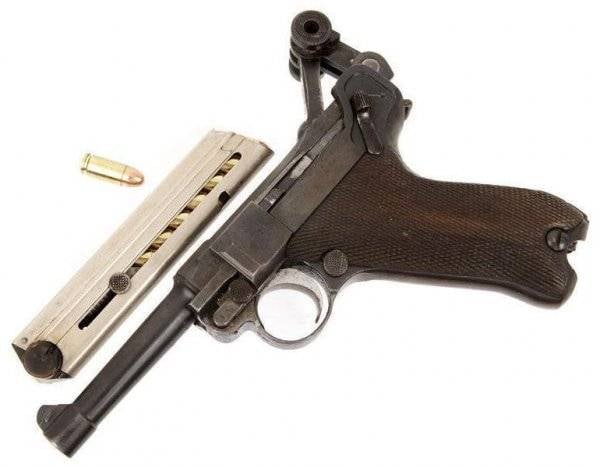
P.08 pistol with detached magazine and open bolt on slide stop
In fact, the entire hinge-lever system according to the device is a crank mechanism, in which the shutter is the slider.
The weight of a standard P.08 army pistol in curb condition was about 950 g, the total length was 217 mm, and the barrel length was 102 mm. Magazine capacity - 8 rounds. Rate of fire - about 30 rounds per minute. The initial speed of the bullet is 350 m / s. For the armament of personnel directly involved in hostilities, a modification was made with a barrel length of 120 mm. From 10 m, a bullet fired from this pistol pierced a German steel helmet. At a distance of 20 m, the bullets were placed in a circle with a diameter of 7 cm. Shooting was most effective at a distance of up to 50 meters.
Later, the German Navy received its own version of the P.08, without the safety on the handle, but retaining the two-position sight and the 147 mm barrel. Such pistols from the P.08 were distinguished by an adjustable sight and the possibility of docking an attached butt.
In addition to the "land" pistols with a barrel length of 102-120 mm, there was an army version with an elongated barrel. This modification is known as the "Artillery Model" or Lange Pistole 08 (LP 08).
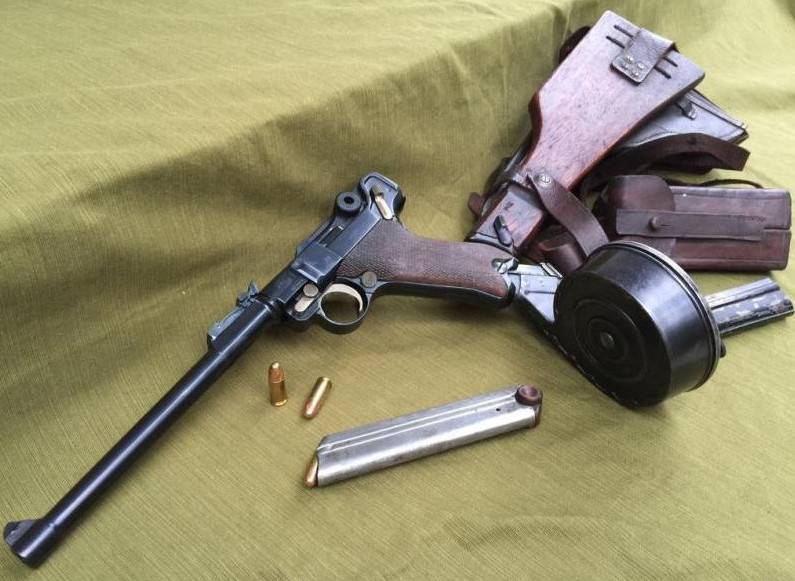
The pistol of the "Artillery model" was intended for arming field artillery gun crews and non-commissioned officers of machine-gun teams. The barrel length of 203 mm and the ability to attach a rigid holster-butt to the weapon significantly increased the range of fire.
The carbine pistol could be equipped with a Trommelmagazin 08 drum magazine for 32 rounds. Although the sights of these weapons were marked at a distance of up to 800 m, the effective firing range with an attached holster-butt did not exceed 100 m. Despite the higher cost, several tens of thousands of LP.1913 pistols were produced from 1918 to 08, and this weapon massively and quite effectively used in the battles of the First World War. Subsequently, the Artillery Model (as pistols with a barrel length of 102 and 120 mm) was in service with the Wehrmacht, the SS troops, the Kriegsmarine and the Luftwaffe.
"Parabellum" for quite a long period of time was considered as a kind of standard and, as is commonly believed, was one of the best pistols of the First World War. One of the main advantages of this 9mm pistol is its high accuracy. Compared to other army pistols of the time, it combined high power with sufficient compactness.
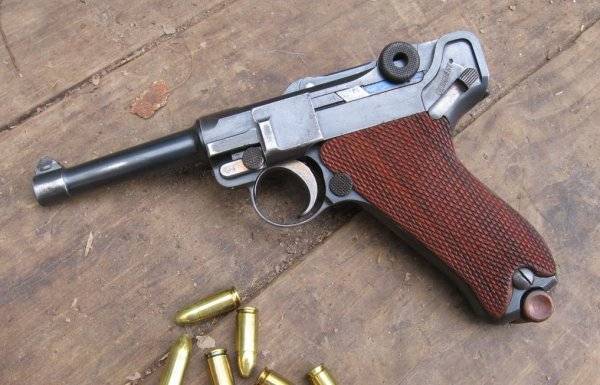
P.08 pistols were of high quality workmanship, good exterior finish, accurate fitting of moving parts and ease of shooting. On weapons of early release, the cheeks of the handle were made of walnut wood, with a fine notch. Pistols produced during World War II may have dark plastic cheeks.
In the interwar period, a slide delay was introduced into the Luger design, which excluded the movement of the bolt forward when the magazine was removed, which increased the practical rate of fire and safety in handling when disassembling the weapon. In addition to the standard army version, in the early 1930s, Mauser-Werke AG produced pistols with an expansion-type silencer.
The 9-mm P.08 army pistol had good combat and service performance. But by the beginning of the 1930s, weapons designed in the early 1939th century no longer met the requirements of mass production. For all its merits, the Luger was too expensive and time-consuming to manufacture. Fine-tuning some parts required the manual labor of highly skilled workers, which greatly complicated the production process. In addition, the officials of the German Ministry of Armaments were not satisfied with the high cost. In 32, the Wehrmacht received a Luger with three magazines for 98 Reichsmarks, at the same time the Mauser 70k carbine cost XNUMX Reichsmarks.
In the early 1930s, Carl Walther Waffenfabrik began designing a new semi-automatic pistol chambered for the 9mm Parabellum cartridge. Initially, the designers, by analogy with the very successful 7,65 mm Walther PP pistol, tried to create a blowback pistol (Walther MP). But a free shutter without an excessive increase in weight did not provide the necessary strength, reliability and safety, and therefore, after a series of experiments, Walter specialists settled on using recoil energy with a short barrel stroke. Locking was carried out by a latch, swinging in a vertical plane and located between the tides of the trunk.
The first two hundred "Walters" under the 9-mm Parabellum cartridge, released in 1936 under the name Armee Pistole, had a hidden trigger location.
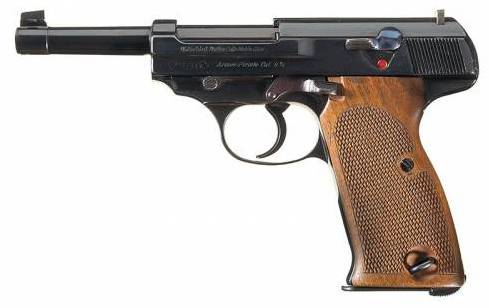
However, after military tests, a pistol with an open trigger and a double-action trigger mechanism, which had the brand name Heeres Pistolen (HP), went into mass production. This pistol entered service in 1940 as the P.38 (Pistole 38).
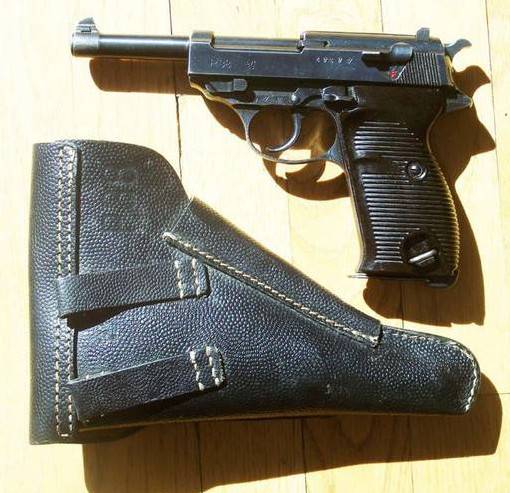
9mm P.38 pistol with holster
Depending on the year and place of issue, the mass of the pistol was 870–890 g. Length - 216 mm, barrel length - 125 mm. Magazine capacity - 8 rounds. Bullet muzzle velocity - 355 m / s.
In 1944, by order of the main department of imperial security, a more compact version was created and produced, with a barrel shortened to 73 mm, which had the designation P.38K.
9-mm "Walter" was mass-produced at the enterprises of Germany, Belgium and the Czech Republic. In total, the armed forces of the Third Reich received about 1 million of these pistols.
Initially, P.38 pistols were issued with walnut grip cheeks, but later they were changed to Bakelite. Pistols produced before 1944 were of very good workmanship. At the end of the war, mass production came to the fore, which negatively affected the exterior finish and reliability.
In the troops, the 9-mm "Walter" has proven itself positively. The pistol had sufficient efficiency, good reliability and accuracy of fire, a high degree of safety in handling. But despite the fact that the R.38 was easier and cheaper to manufacture than the R.08, the new German army pistol turned out to be quite complex, had many parts and springs.
For comparison: in the design of the P.38 pistol, there were 11 springs, mostly small, while in the design of its predecessor, the Luger P.08 pistol, there were only 8 springs. In addition, under equal conditions, the R.38 with a barrel length of 125 mm was somewhat inferior in accuracy to the old R.08, which had a barrel length of 120 mm. Due to the thick grip, the P.38 was less comfortable than the P.08 for shooters with a small hand.
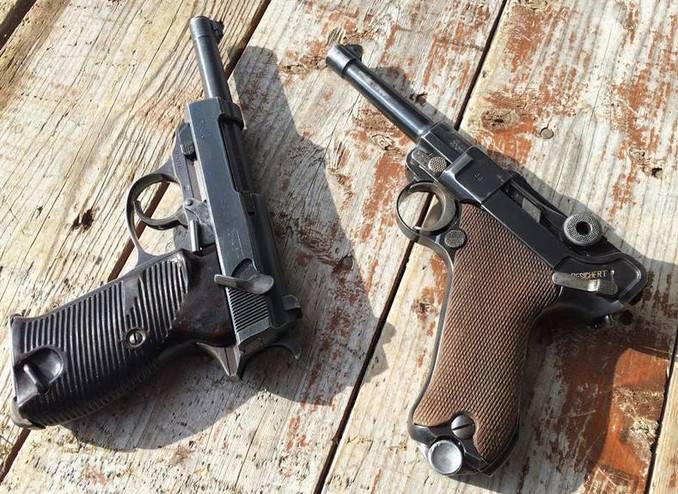
In the second half of 1943, the number of 9-mm "Walters" in the army became more than the "Lugers". Nevertheless, both pistols were actively used by all branches of the armed forces and various paramilitary formations until the surrender of Nazi Germany.
Pistols chambered for 7,65 mm Browning: Walther PP, Walther PPK and Mauser HSс
Under the restrictions imposed on Germany after the defeat in the First World War, the German industry could not produce pistols with a caliber of more than 8 mm and with a barrel length of more than 100 mm.
Under these conditions, in 1929, Carl Walther GmbH created a very successful Walther PP pistol (Polizeipistole) chambered for the 7,65 × 17 mm cartridge popular at that time.
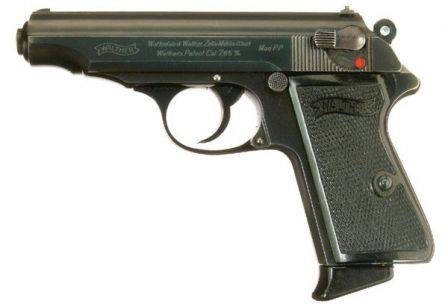
Early pre-war 7,65 mm Walther PP pistol
The automatics of the Walther PP pistol are based on the blowback recoil scheme, which was possible due to the use of a relatively low-powered 7,65 mm Browning cartridge. The shutter-casing is held in the extreme forward position by a return spring located on the barrel. The trigger mechanism of the hammer type, double action allows a shot both with a pre-cocked and with a lowered trigger.
The design of the trigger mechanism includes a hammer release and its safety cocking - qualities that are important for safety. There is also an indicator of the presence of a cartridge in the chamber, which is a rod, the back of which protrudes beyond the surface of the shutter-casing above the trigger when the weapon is loaded. Such a device makes the gun much safer, as the owner can tell if a cartridge is in the chamber, even by touch.
The gun turned out not only beautiful, but also compact, simple, easy to handle and safe. With a sent cartridge, it has the ability to quickly open fire. Weight without cartridges is 0,66 kg. Total length - 170 mm. Barrel length - 98 mm. The initial speed of the bullet is 320 m / s. Sighting range - up to 25 m. Magazine for 8 rounds.
Although the Walther PP was not initially considered as a military pistol, its positive qualities, commercial success in the civilian market, popularity with the police and security forces contributed to the fact that the Army Ordnance Department also ordered a large batch of such pistols.
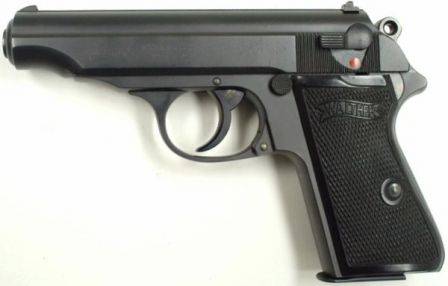
7,65mm Walther PP pistol issued during the war
Although the 7,65 × 17 mm cartridge was significantly inferior in energy to the 9 × 19 mm cartridge, in most cases, staff officers, rear and auxiliary service officers did not need a powerful army-style pistol, and the use of the compact and lightweight Walther PP by those who did not directly participate in combat actions was entirely rational.
Experienced shooters, who had the opportunity to compare the Walther PP with the P.08 and P.38, noted at a distance of up to 20 m in equal conditions the 7,65 mm pistol showed better accuracy than 9 mm pistols. Due to the lighter weight, the weapon chambered for 7,65 mm was easier to control, and the recoil and sound of the shot were easier to bear for the shooter.
At the same time, a 9 mm cartridge with a muzzle energy of a bullet of about 480 J was more than twice as superior as a 7,65 mm cartridge with a bullet energy of about 220 J. This (in combination with a larger caliber) meant that the "Parabellum" 9 -mm bullet, when hit in the same part of the body as a 7,65 mm bullet, has a much greater probability of quickly incapacitating the enemy and depriving him of the opportunity to fire back.
Due to the small dimensions of the 7,65-mm Walther, it was easy to carry covertly, which was appreciated by police and security operatives who carried out operational-search activities in civilian clothes. Pistols Walther PP quite often had crews of armored vehicles, pilots, sailors, couriers and staff officers.
In 1944, due to the lack of pistols chambered for 9 × 19 mm Parabellum 7,65 mm Walther PP pistols, junior officers of the Wehrmacht began to be equipped regularly. Until April 1945, the German government, secret services, police and armed forces received about 200 Walther PP.
In parallel with the 7,65 mm Walther PP, the Walther RRK (Polizeipistole Kriminal) was produced. This more compact and lightweight pistol for the same ammunition appeared in 1931.
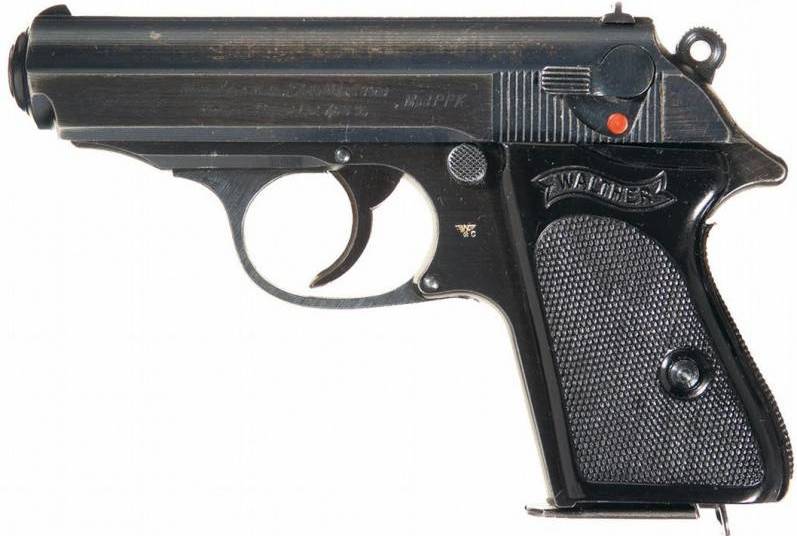
7,65 mm pistol Walther RRK
The Walther PRK pistol is designed on the basis of Walther PP. At the same time, the design of the frame and the shutter-casing, which received a different shape of the front part, was somewhat changed. The length of the barrel has decreased by 15 mm, the overall length by 16 mm, and the height by 10 mm. Weight without cartridges - 0,59 kg. The initial speed of the bullet is 310 m / s. Magazine for 7 rounds.
Before the surrender of Germany in May 1945, Carl Walther Waffenfabrik managed to produce about 150 Walther RRK pistols. Such pistols were used by the criminal police and the Gestapo, officers of the Luftwaffe, rear units of the ground forces, as well as command staff.
The success on the market of the Walther PP small-sized self-loading pistol with a self-cocking mechanism could not but give rise to a number of attempts to compete with it. One of the successful examples was the HSc pistol (Hahn-Selbstlspanner pistole ausfurung C - self-cocking pistol, modification C), released by Waffenfabrik.
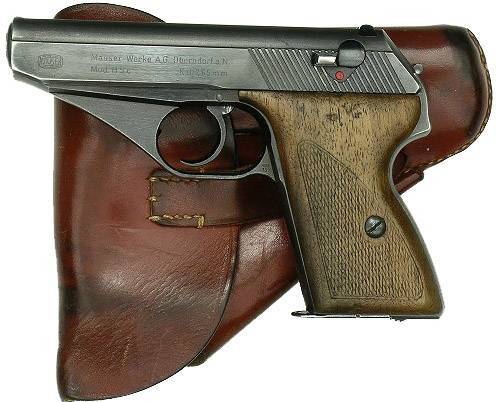
7,65mm Mauser HSc pistol with holster
These pistols were armed with the highest command staff, secret police operatives, saboteurs, Luftwaffe and Kriegsmarine officers. The serial production of this elegant weapon began in 1940. Over 250 copies were produced in five years.
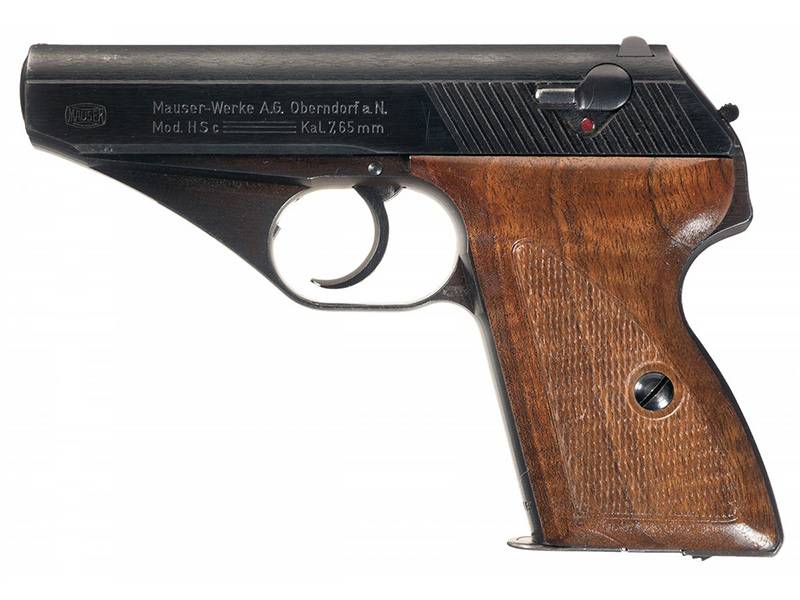
The weight of the Mauser HSc pistol without cartridges is 0,585 kg. Length - 162 mm. Barrel length - 86 mm. Magazine capacity - 8 rounds. Width - 27 mm, which is 3 mm less than Walther PP.
Like other examples of this caliber, the Mauser HSc is a self-loading pistol built on automatic blowback and has a double-action trigger mechanism.
The shape of the pistol and sights are optimized for concealed carry. The front sight of small height is hidden in the longitudinal groove and does not protrude beyond the contour of the weapon. The trigger is almost completely hidden by the bolt, and only a small flat spoke protrudes outward, allowing you to cock the trigger manually if necessary, but practically eliminating the possibility of catching the trigger on clothes when drawing the weapon.
A non-automatic safety lever is mounted at the rear of the shutter. The lower position of the flag corresponds to the "fuse" state (the drummer is blocked and removed from under the trigger), the upper one - "fire". There is also an automatic fuse that blocks the trigger when the magazine is removed, which ensures safety when disassembling or unloading the weapon.
Pistols of early production were distinguished by excellent workmanship and surface treatment, walnut handle cheeks were placed on them, in 1944, to reduce the cost of production, the production of pistols with plastic cheeks began.
Post-war use of German pistols Luger P.08, Walther R.38, Walther PP, Walther PPK and Mauser HSс
German pistols were a very desirable trophy for both Soviet and American soldiers. Unlike captured machine guns, rifles and machine guns, in the Red Army, the "short-barreled" was not taken into account so strictly and was often hidden by military personnel directly involved in hostilities or located in the front line.
It was very prestigious for a Soviet officer to have a Walther, Mauser or Parabellum pistol as a personal weapon, and fighters at the front often presented captured pistols to deserving commanders. Also, short-barreled trophy weapons were usually a means of stimulation in the course of communication with quartermasters, when it was necessary to obtain scarce property, or served as a valuable gift for higher commanders.
After the end of hostilities, most of the German-made pistols in hand were seized, leaving only official award weapons, and by the beginning of the 1950s, captured pistols were almost never used in the Soviet Army.
After culling and inventory, German-made pistols were mainly distributed to the armories of military districts. A significant part was placed at the disposal of the state security and internal affairs bodies, and a very small amount ended up in the armories of film studios and museums.
Short-barreled weapons intended for filming in films were altered so that they could only be fired with blank cartridges, and at the same time, automation was ensured. Museum exhibits were brought into non-working condition while maintaining their appearance.
It is reliably known that many state security officers who fought against the "forest brothers" in the Baltic states and nationalists in Western Ukraine had 9-mm German pistols as personal weapons.
Captured pistols Walther PP and Walther PPK for a long time were the personal weapons of Soviet diplomatic couriers and prosecutors. Several thousand compact 7,65-mm pistols were donated to award funds, and they are still on the list of weapons that can be awarded to senior law enforcement officers, deputies and high-ranking officials.
Things were different with the Allies; after the end of the war, many American servicemen brought with them captured pistols from Europe to the United States.
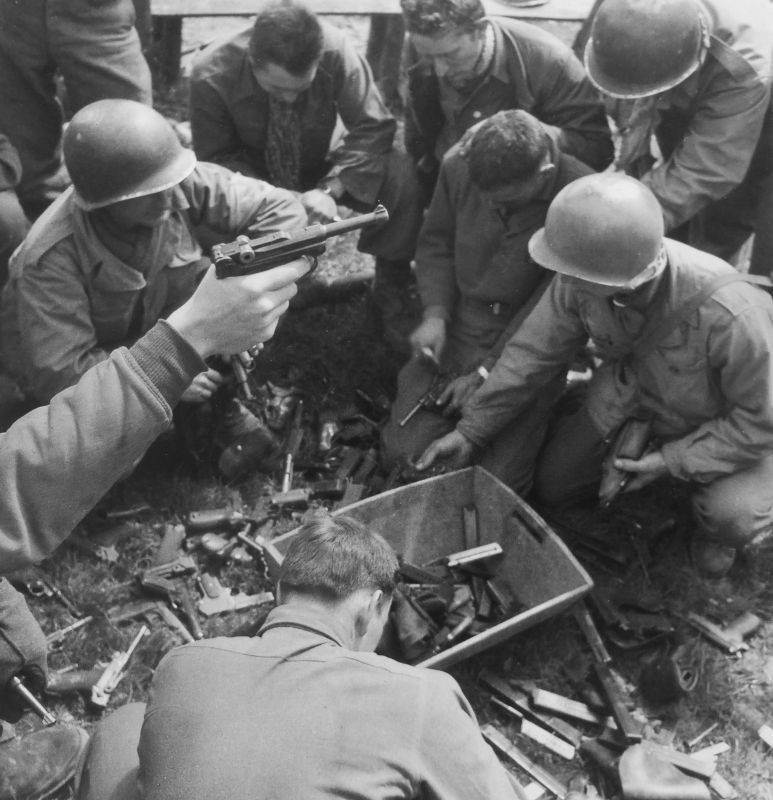
American soldiers inspect captured German pistols captured in Berchtesgaden
At present, a significant number of such weapons have been preserved in good condition, and German-made pistols often pop up at gun auctions. The cost of original copies that are in good technical condition and have a confirmed history, reaches tens, and sometimes hundreds of thousands of dollars.
The 9mm Parabellum and Walther pistols had a resource of up to 10 shots and, with proper care, could be used for a very long time. German-made pistols were actively supplied to third countries, widely distributed throughout the world and used in many conflicts.
For example, R.08 and R.38 were officially in service with the Afghan army and, according to the recollections of Soviet veterans who performed international duty as part of a limited contingent, Afghan officers had such pistols in the 1980s.
At least until the mid-1950s, Lugers and Walthers were used in the armed forces of European countries liberated from Nazi occupation, in the GDR and the FRG.
In the post-war period, P.08 pistols were assembled in France at the MAS factory in Chatellerault, for which machine tools and a large number of semi-finished products were taken from the German Oberndorf. For the French armed forces, more than 1949 pistols were assembled until 4, some of them were stored in the warehouses of the gendarmerie until the mid-000s.
Until the end of the 1980s, the R.08 pistols remained in service in Portugal, Sweden and Norway. A very significant number of "Parabellum" is in the possession of individuals in countries with liberal gun laws.
In 1957, the Bundeswehr adopted the P.1 pistol, which differed from the early Walther P.38 in an aluminum frame. The mass of an unloaded pistol decreased to 770 g. The improvement of the 9-mm "Walter" in Germany did not end there. In 1975, a reinforcing transverse hexagonal rod was introduced into the design of the pistol, located in the frame in the area where the barrel locking larva was located.
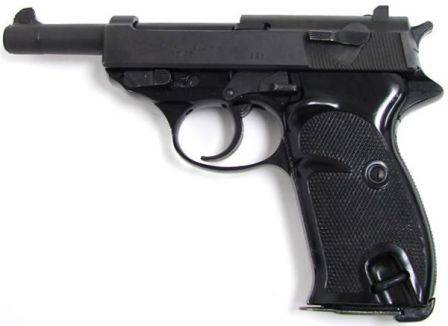
9 mm pistol R.4
In the early 1970s, the P.4 pistol was created for the German police, which was a modification of the P.1 pistol with a barrel shortened to 104 mm and an improved safety mechanism. The mass of this pistol was 740 g. The release of the R.4 continued until 1981.
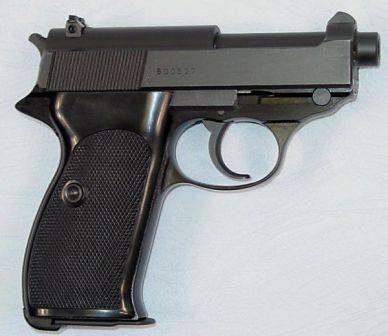
For concealed carrying by employees of the anti-terrorist units of the FRG, an even shorter-barreled version was created, which had a barrel only 90 mm long, barely protruding forward from the short casing of the shutter.
In addition to Germany, R.38 pistols were produced in France. Manurhin manufactured them under license from Walther. In France itself, they were used to a limited extent and were mainly exported.
Even before the war, the 7,65 mm pistols Walther PP and Walther PPK won their niche in the world market in the segment of compact service and civilian pistols. After the surrender of Germany, the production of these pistols in the late 1940s was launched in France, Hungary and the GDR. At various times, 7,65-mm "Walters" were also produced in Romania and Turkey.
The French company Manurhin produced 7,65 mm Walters until 1989. The Walther company itself revived the production of such pistols in the early 1950s and carried it out until the end of the twentieth century.
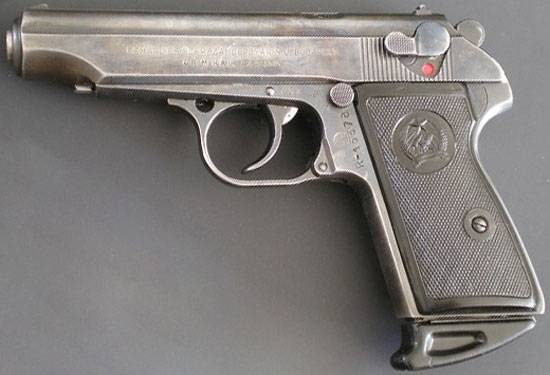
7,65 mm Hungarian pistol Femaru 48M
The Hungarian version of the 7,65 mm Walther PP pistol, manufactured by Femaru, received the designation 48M. These pistols were supplied to the Hungarian police and security forces.
In China, a copy of the Walther PPK has been produced since the early 1950s under the designation Type 52.
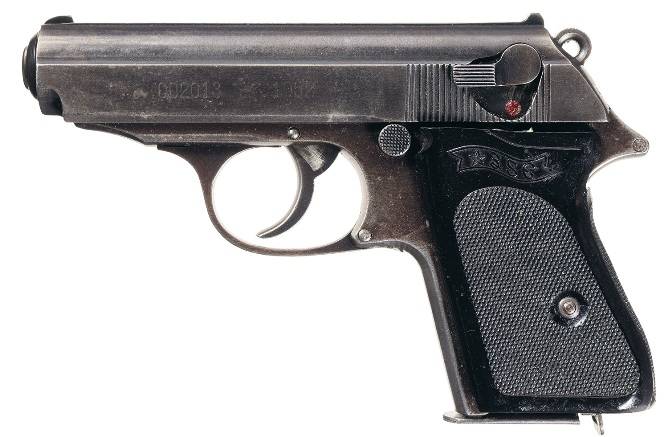
7,65 mm Chinese pistol Type 52
The Type 52 pistol was used by Chinese police and high-ranking officers who needed a more compact and light personal weapon than the Type 51 pistol, then in service with the PLA, which is a copy of the TT. The Type 52 pistol differed from the German Walther PPK in much worse workmanship and surface finish.
Licensed production of the Walther PPK in the United States began in the early 1970s. The release of pistols was carried out by Interarms and Smith & Wesson.
The assembly of 7,65 mm Mauser HS pistols with Heckler und Koch GmbH was resumed in Germany in 1968 and continued until 1977. Most of the issued pistols were sold to private individuals in the United States, where the pistols were supplied in two surface finishes - blued and nickel-plated.
To be continued ...
Information